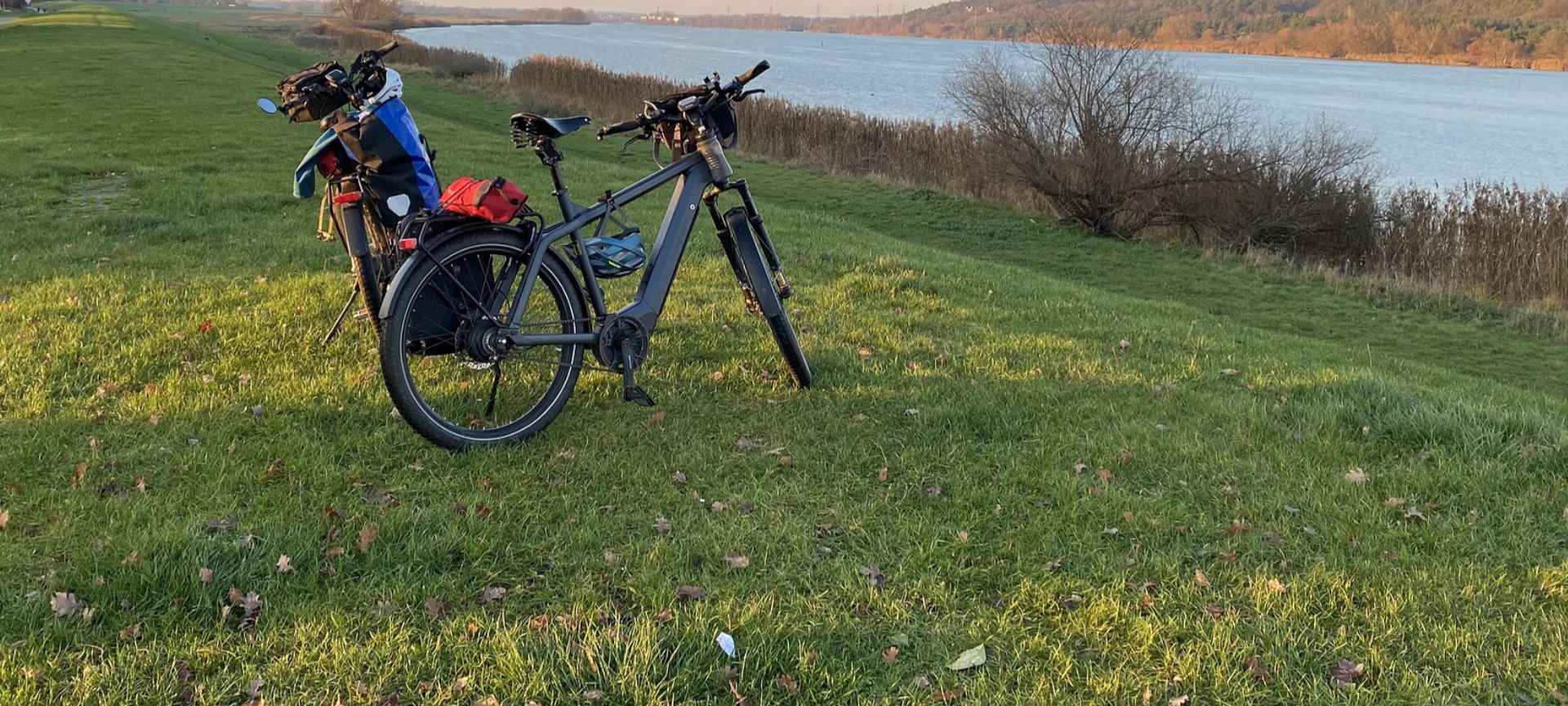Travelling with your electric bike
The health crisis of the last 18 months, and the associated confinements, have prompted a growing number of people to (re)discover the joys of cycling. Published online on 8 April, the Cycle Observatory's report confirms that bicycle sales are reaching record levels. With 514,672 models sold in 2020, the VAE - electrically assisted bicycle - represents 19% of the cycling market, an increase of 29% on 2019.
Practical and economical, the electric bike is proving to be an effective alternative that is accessible to everyone for travelling on 2 wheels just about anywhere, in town or country, on the plains or in the mountains. Why set off with an electric bike? Which model should you choose? How do you organise your motorised bike tour? We take a look at the advantages and disadvantages of this particular means of locomotion, ideal for taking in the sights without getting your trunks (too) wet!
A brief summary for those who missed out on the media hype surrounding electric-assist bicycles: electric bikes look like conventional bicycles, except that they have extra features. They have a battery, a motor and a control console. The purpose of this additional equipment is to help the cyclist pedal and negotiate steep inclines.
Generally located in the bottom bracket or inside the wheel hub, the motor starts when you press on the pedals and stops when you brake. Under European legislation, its power is limited to 250 W. The battery is hidden under the saddle, on the luggage rack or on the crossbar of the bike. It can be recharged at electrical points available in towns and cities, or from a mains socket. Range varies from model to model, and this is one of the stumbling blocks when choosing an electric bike. If you want to travel far, you know you have to choose the right bike. With an electric bike, this assertion takes on another dimension: in this case, you need to choose a model that will give you maximum range.
Watch out, you're pedalling! An electric bike is not a moped, and you have to pedal to make it go. So don't get lazy! Electrically-assisted bicycles have a maximum speed of 25 km/h. Beyond that, the motor stops automatically and your calves have to take over. Some models go as fast as 35 km/h, provided you pedal harder. This is the case, for example, with the Extrbici RS600. On the other hand, one of the big advantages of this type of machine is that it doesn't need a number plate or vehicle registration document, and it's allowed to use cycle lanes. In other words, the whole of the French network - roads, tracks and paths - is open to you!
10 tips for travelling with an E-bike

If you've fallen for the electrically-assisted bike, all that's left is to try it out under the right conditions, i.e. on holiday and on a ride - which, like any self-respecting ride, is best organised in advance.
1. Choosing the right electric bike
Whether for urban use or touring, the best choice is the electric-assist VTC, which adapts to all distances and remains the most comfortable. Fancy a more extreme ride? Go for the electric mountain bike, which is highly versatile and can go anywhere. Choose mid-motor technology, which is more efficient for mountain biking, and go for a well-known brand that can provide a breakdown service just about anywhere in France.
2. Put your trust in an expert
Are you already the proud owner of an electric bike? Before you set off, take it to a bike repairer for a quick overhaul, or get a diagnosis from Decathlon to find out how long you'll be able to ride on average with your battery charged. This is vital information when it comes to planning your itinerary.
3. Plan your route
Taking into account your level. Are you a beginner? Choose a short itinerary over a few days, with only a few kilometres per day. The electric bike will help you, but it won't do everything, so watch out for muscle soreness! If you're travelling with children, cycle in the mornings and plan activities for and with them in the afternoons, so as not to tire them out. Include in your itinerary the detours and stops needed to discover the many resources (geographical, heritage, culinary...) of the areas you pass through; and check in passing that there are enough electric recharging points on the route to spare you any setbacks.
Discover the top 5 most beautiful places in France for electric mountain biking
4. Choose accommodation with the "Accueil Vélo" label
In France, there are more than 3,000 Accueil Vélo-labelled service providers (accommodation, restaurants, cycle hire and repair firms, etc.) who guarantee facilities that are useful to cyclists: secure shelters, terminals for recharging batteries, repair kits, luggage transfer, etc. The list goes on. The www.francevelotourisme.com website is one way of finding the people you need to talk to when you're out and about.
5. Travel light
The weight of your luggage has a direct impact on battery consumption. So stick to the bare essentials (light, space-saving clothes, toiletries, repair kit), well organised and balanced in your panniers. A tarpaulin can be useful for quick shelter in the event of a shower or thunderstorm. And don't forget to pack water and cereal bars to keep you going: even with electric assistance, pedalling is still a sport!
6. Safety first and foremost!
Wear a helmet and carry a basic kit containing the tools you need to repair a punctured tyre. Check the lights on your bike and wear colourful clothing. The slogan "Seeing is believing" still applies today!
7. Monitor the battery level
This is one of the disadvantages of an electric bike, but you travel at the pace of your battery. In economy mode on the flat and downhill, it switches to the "sport" or "turbo" version for uphill climbs. Keep the power assist switched on even if you don't really need it, to avoid an excessive increase in power consumption. Take along a spare battery, which you can hire. This will prevent you from running out of power in the middle of nowhere, 45 km from the next electricity point. Identify the charging points on your route, and systematically recharge your battery every evening. Range extenders are also available for certain brands. Lighter to carry than a conventional battery, they allow you to extend its life. Don't forget that, like any battery, the battery in your electric bike needs to be looked after: keep it out of the sun and maintain a minimum charge level of 30% (50% is better).
Discover our guide to electrically assisted bicycles here
8. Choose clothing suitable for cycling
This means cycling shorts with a reinforced seat, breathable T-shirts, a waterproof windbreaker, a fleece jacket to keep out the early-morning chill and comfortable shoes.
9. Take the time to live and look at the landscape
By taking on some of the physical effort needed to make it go, the electric bike frees your mind from certain constraints. Take the opportunity to observe what's going on around you, and make plenty of stops: in restaurants to sample local specialities, at craftsmen's shops, in the towns and villages you pass through. In this way, the energy you spend less on pedalling will be reused in a different way. The other advantage is that you won't be drenched in sweat at every stop!
10. Make time for everything
The electric bike allows you to rediscover the art of wandering. By freeing up your time on the route and saving your strength, it allows you more time to relax and discover the landscapes and residents of the regions you pass through. Keep this in mind when you plan your itinerary.
The advantages and limitations of travelling by electric bike

The benefits of electric bikes
The main advantage of the electric bike is that it allows everyone to go cycling, including those who are not experienced sportsmen and women. Even without training, you can take to the road and ride for days on end. This time, it's your bike that takes the strain, especially on hills!
Secondly, the benefits of the electric bike are the same as those of cycling and cycling in general. Cycling is excellent for keeping fit, maintaining your muscles, breathing and heart. The WHO (World Health Organisation) claims that 30 minutes' cycling a day could extend human life expectancy by 8 years.
In town, the electric bike is an easy alternative to the car for getting around, with a carbon footprint that is undeniably better for the environment. It's easier to park, and avoids traffic jams.
The electric bike is also economical: that's one of its main advantages. The example often given is that a car costs around €0.85 in petrol per kilometre (€85 per 1,000 km). An electrically-assisted bicycle, for the same distance, only costs €0.01, or €1 per 1,000 km. It's easy to do the math... over the same distance. What's more, an electrically-assisted bicycle is silent and imposes no constraints or administrative formalities on you: no registration, no vehicle registration document, no technical inspection required.
The limits of electric bikes
While the many advantages of electric bikes make them a good choice, they do have their limitations. The frequent need to recharge the battery remains a drawback. Whereas a conventional bicycle offers nothing but freedom and autonomy, the possibility of going far without depending on anyone, an electric bicycle requires its users to be extra vigilant. Every day, you have to look for, and find, a charging point (rarely available in the wilderness). In the end, the battery's autonomy and the level of charge remaining can determine the rest of your journey at the end of the day.
Another point to consider is that electric bikes are often banned from public transport, particularly on planes. Any rechargeable lithium battery over 100 W is not allowed in the hold. Most bus companies also refuse them. In any case, it weighs so much (25 kilos on average) that charging it, on a train for example, requires a good dose of arm muscles as well as a suitable and sufficiently solid support.
All in all, between the advantages and disadvantages, it would seem that trying an ECV is often the same as adopting it. Here's Olivier Godin's account of his journey through the Alps on an electrically assisted bike.
He shares his experience of travelling with an electric bike
"For a long time, I thought that electric bikes were only for urban or utilitarian use. Then, when I was writing my latest book, À vélo, I had the opportunity to try one out in touring mode. And I was pleasantly surprised. Recent models designed specifically for touring, like the Kalkhoff Entice 3.B Move that I had in my hands, offer excellent performance in terms of comfort, power and above all range. During my crossing of the Northern Alps, between Grenoble and Lake Geneva, I was able to cover stages of 85 km and over 1,500 m without my battery running down.
Of course, touring on an electric bike requires a bit more planning than on a conventional bike. It's hard to improvise a bivouac when you're still dependent on a recharging point in the evening. Fortunately, however, it's becoming easier and easier to find one. To keep pace with the growth of this phenomenon, local authorities and the tourism industry are stepping up the number of facilities available. You can now plug in at tourist offices, campsites and even supermarkets. Bosch, the market leader, has launched its own network of recharging stations, notably on the Grandes Alpes route.
For my part, with the Bosch FastCharger, my battery recovered half its range in just over an hour's charge (3 hours for a full charge).
Although the practice is still in its infancy, long-distance touring by electric bike seems to me to have a bright future ahead of it. Electric assistance makes it easier to access difficult terrain. With an electric bike, the passes of the Alps are open to as many people as possible. Beware, however, that the motor isn't everything. To climb, you need to make an effort, albeit a small one, but an effort nonetheless. If you want to last, don't expect to climb every hill in turbo mode! " Olivier Godin















